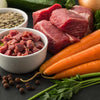Do You Need to Add Supplements to Raw Dog Food? Understanding Nutritional Needs for Your Canine Companion
- Houndsy
Table of Contents
- Introduction
- Understanding Raw Dog Food Diets
- Signs of Nutritional Deficiencies in Dogs
- The Risks of Using Supplements
- When Should You Consider Supplementing?
- Practical Tips for Supplementing Raw Dog Food
- Conclusion
Introduction
Did you know that nearly 30% of dog owners in the U.S. are choosing to feed their pets a raw diet? This significant shift towards natural feeding acknowledges the benefits of fresh, unprocessed foods. However, many dog owners find themselves grappling with a crucial question: do you need to add supplements to raw dog food?
As passionate pet parents, we want the absolute best for our dogs. With the rising popularity of raw diets, understanding their nutritional makeup becomes essential. While a raw diet can provide many of the necessary nutrients, some dogs may still exhibit deficiencies. This blog post will explore when and why adding supplements might be necessary, the implications of synthetic vitamins, and how you can effectively enhance your dog’s diet without compromising health.
Throughout this post, we will cover the importance of balanced nutrition for dogs, which nutrients might be necessary to supplement in a raw diet, and how to choose the right supplements if needed. By the end, we aim to help you make informed decisions about your dog’s diet and feeding routine, taking insight from both science and the collective experiences of dog owners.
Specifically, we will discuss:
- The basics of raw dog food diets and their nutritional components.
- Signs that indicate a potential nutritional deficiency.
- Risks of supplementing with synthetics versus natural alternatives.
- Practical tips for adding necessary supplements if required.
As you reflect on your pet’s current feeding routine, we encourage you to consider not just what goes into your dog's bowl but also the broader implications for their overall health and wellbeing.
Understanding Raw Dog Food Diets
What Constitutes a Raw Dog Food Diet?
A raw dog food diet, often referred to as a "BARF" (Biologically Appropriate Raw Food) diet, is primarily composed of uncooked meat, vegetables, fruits, bones, and organs. This menu is designed to mimic what dogs might eat in the wild—prior to domestication. Each component offers unique benefits to your dog's health, promoting energy levels, healthy skin, and a shiny coat.
Key Components of a Raw Diet
- Meats — the primary protein source, providing essential amino acids.
- Bones — an important source of calcium and phosphorous crucial for bone health.
- Organs — rich in vitamins and minerals, organs like liver can boost nutritional intake.
- Vegetables and Fruits — provide fiber, vitamins, and antioxidants.
While feeding raw, pet parents often focus on quality over quantity, highlighting the significance of fresh, ethically sourced ingredients.
Nutritional Advantages of Raw Dog Food
Transitioning to a raw diet can yield several advantages for your dog:
- Better Digestion: Dogs on raw diets may experience improved digestion due to the elimination of fillers often found in kibble.
- Less Odor: Many owners report that dogs on raw food have fresher breath and less odor overall.
- Weight Management: Raw diets tend to promote healthier weights as they often contain fewer empty calories.
However, we must also acknowledge that a raw diet can sometimes lead to nutritional gaps, especially if not balanced correctly. This brings us back to the central question: do you need to add supplements to raw dog food?
Signs of Nutritional Deficiencies in Dogs
Common Indications That Your Dog May Require Additional Supplements
Recognizing whether your dog is receiving the appropriate nutrients from a raw diet can be a challenge. Here are some common signs that might indicate deficiencies:
- Skin Issues: If your dog develops dry, flaky skin or excessive itching, essential fatty acids or vitamin supplementation may be necessary.
- Poor Coat Quality: Dull fur or excessive shedding may signal inadequate nutrient absorption or missing vitamins like A, D, or E.
- Lethargy: An overall lack of energy may point to a deficiency in B vitamins or iron.
- Digestive Disturbances: Diarrhea or irregular bowel movements can be a direct indication of nutritional balance issues, often due to inadequate fiber or probiotic sources.
If your dog exhibits any of these symptoms, it may be time to assess their diet—and consult with a veterinarian experienced in canine nutrition about potential supplement needs.
The Risks of Using Supplements
Synthetic Supplements: Pros and Cons
While it may seem convenient to add synthetic vitamins to your dog's diet, healthcare professionals often discourage relying on them. Here are a few reasons why:
- Bioavailability Issues: Synthetic vitamins often do not provide the same absorption levels as those sourced from food. The body struggles to recognize and utilize them effectively.
- Potential for Toxicity: Over-supplementation of fat-soluble vitamins can lead to toxic build-ups, posing a severe risk to your pet's health.
- Nutrient Interaction: Ingesting synthetic additives can interfere with the body's natural nutrient receptors, sometimes causing deficiency symptoms to mimic.
To minimize these risks, we encourage adopting a more mindful approach to supplementation—consider natural sources first.
Natural Alternatives: Whole Foods and Herbs
Instead of synthetic supplements, consider enriching your dog's diet with whole foods. Here are some outstanding natural sources to bolster their nutrition:
- Fish Oils: Rich in Omega-3 fatty acids, beneficial for skin, coat health, and joint support.
- Pumpkin Puree: A fantastic source of fiber and essential vitamins like C and E, which aid digestion and contribute to overall health.
- Bone Meal: Can be introduced if your dog isn't consuming an adequate amount of meaty bones, providing a direct source of calcium and phosphorus.
- Green-Lipped Mussel: Known for its anti-inflammatory properties, perfect for dogs with joint issues.
Always consult with a veterinarian before making any modifications to your dog’s diet.
When Should You Consider Supplementing?
Individual Needs Will Dictate Supplementation
Each dog is unique, and their dietary needs can vary based on breed, age, activity level, and health conditions. Below are scenarios that may warrant supplementation:
- Age-Related Needs: Senior dogs often require enhanced joint support or specific vitamins and minerals during their geriatric years.
- Health Conditions: Dogs with specific health concerns like kidney disease or allergies may require specialized diets with tailored supplements.
- Dietary Restrictions: If certain foods (like fish or particular meats) cannot be sourced or tolerated, supplementation may be necessary to cover nutritional bases.
Practical Tips for Supplementing Raw Dog Food
- Consult a Canine Nutritionist: Seek tailored advice based on your dog's unique health profile.
- Start Slowly: If introducing new supplements, proceed with caution. Monitor your dog closely for any changes in health or behavior.
- Focus on Quality: Select high-quality, reputable supplements that prioritize natural ingredients.
This thoughtful approach to supplementation, in conjunction with a well-planned raw diet, can help ensure your dog is receiving all necessary nutrients.
Conclusion
Navigating the world of dog diets can be challenging, especially when it comes to understanding the necessity of supplements. While a well-balanced raw diet can provide many benefits and meet your furry friend's nutritional needs, some dogs may require extra support through quality supplementation.
Reflecting on our discussion today, we encourage you to assess your dog's feeding routine and observe for signs that may indicate the need for added nutrients. Remember, every dog is different; their needs can evolve over time. Thus, staying informed and engaged in their care is essential.
If you find that your pet might benefit from a refined feeding experience, including a smarter solution for their meal routines, consider our Houndsy Kibble Dispenser. With its elegant design and ergonomic convenience, it complements a beautifully curated feeding time. Explore more here.
Frequently Asked Questions
1. Can I transition my dog directly to a raw diet?
Transitioning should be gradual. Start with a mix of current food and raw meat to help their digestive system adjust.
2. How long can I keep raw dog food in the freezer?
Raw dog food can typically be stored in the freezer for up to six months, but always check for freezer burn or off-putting odors before serving.
3. How do I know if a supplement is good for my dog?
Research the ingredients and consult with your veterinarian to ensure they are safe and beneficial for your dog’s dietary needs.
4. Are there any foods I should absolutely avoid in a raw diet?
Yes, foods like chocolate, grapes, onions, and certain nuts can be toxic to dogs and should be strictly avoided.
5. How can I ensure my dog is getting a balanced diet?
Work with a veterinary nutritionist to design a diet plan specific to your dog’s needs, considering personal habits and health.
Investing time in understanding your dog’s dietary needs will undoubtedly enhance their health and happiness. Here’s to many delightful days of shared meals and lasting companionship!












